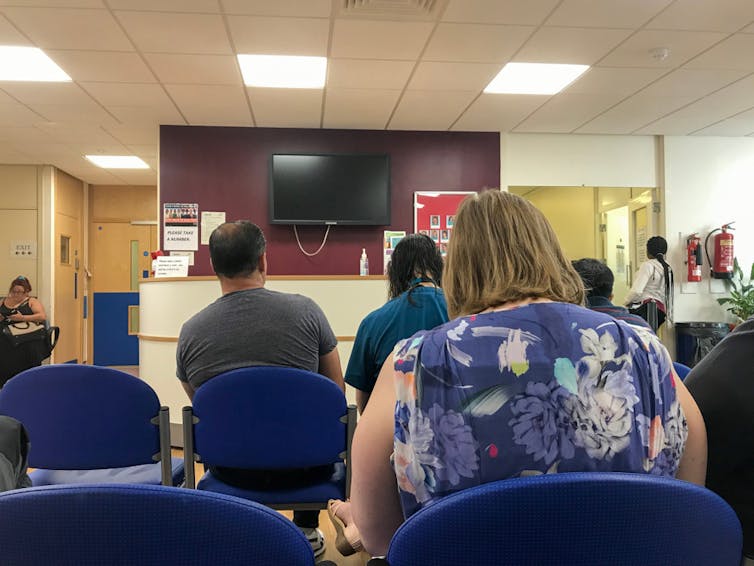
The NHS is, once again, a central plank of pre-election debate and given the public’s views on the future of the NHS, waiting times and staffing numbers are being rightly scrutinised. Less attention, however, is being paid to the hidden health agenda of out-of-pocket spending. Along with Anita Charlesworth from the Health Foundation think tank, we’ve been looking at the reasons why this has been increasing recently.
What is out-of-pocket spending?
Out-of-pocket spending is not covered by private medical insurance or the NHS. It is dominated by people paying out for their long-term care but also includes diagnostic tests, inpatient care (such as cataracts) and outpatient care (such as physiotherapy), and medical goods, including over-the-counter pharmaceuticals. Dentistry is also an increasingly important area of spending.
A growing proportion of UK health spending has been classified as out-of-pocket. In 2021, it accounted for 12.7% of UK health spending, but this has varied over time. In 1997, for example, it comprised of 18% of UK health spending, falling to a low of 11% in 2006 before growing again to 16% in 2019. During COVID-19 this percentage fell again but it is now increasing, reaching 13.9% in 2022.
Out-of-pocket spending is now equivalent to 1.4% of the UK’s GDP. By international comparisons, the UK ranks just below the EU14 and quite far below the EU27 average.
Why is out-of-pocket spending rising?
In the UK, the current scale of self-funding reflects a combination of five factors:
1. NHS crisis. Waiting lists and times have increased since 2012, with a backlog of more than 7.5 million. Private medical insurance is often seen as beyond the financial means of many and while out-of-pocket spending for individual treatments is still relatively expensive, some people feel “forced” to self-fund. Some are even choosing to crowdfund their own care.
A combination of limited NHS capacity and increased waiting times is leading to greater dissatisfaction with the NHS. In dentistry, public funding fell by 15% and patient charges rose by 8% in real terms between 2014-15 and 2019-20. The private sector often highlights poor NHS performance, for example long waiting lists, to stoke demand for its own services.

2. Long-term care. While Scotland has free personal care, long-term care in the rest of the UK is subject to both a needs and means test, meaning some people need care but don’t qualify. There is no general protection against catastrophic cost. In 2015, legislation was passed to introduce a cap on care costs and raise the means-tested thresholds but implementation has been repeatedly postponed.
3. Private healthcare. Private healthcare has been changing, especially since the 2008 financial crisis. Employer-based and subscription insurance schemes have become less attractive and more expensive. The impact of this has been a shift in emphasis of marketing by the private medical sector towards self-pay schemes for one-off treatments. Between 2019 and 2021, there was a 29% increase in the number of “self-pay admissions” while over the same period, there was a 16% fall in the number of “insured admissions”.
4. Public attitudes. While some patients may seek a more active role in choosing providers, this is likely to be unevenly spread across the population, with variations according to how old you are and what socio-economic class you are in. But this is difficult to separate from the broader context of dissatisfaction, and pessimism about the state of NHS provision.
Public dissatisfaction with the NHS has been on the rise for some time, with only 24% of the public saying they were satisfied in 2022, a fall of 36 percentage points from 2019. While surveys suggest the public still tend to prefer to be treated in NHS facilities, 31% don’t have a preference between public and private providers.
5. Policy. Private providers are increasingly being commissioned in England, which blurs the lines between NHS and private in patients’ minds. Private providers deliver services and compete with public sector organisations for public funding. Over-the-counter payments for some pharmaceuticals (since 2023, including treatments for sore throat) are also available. Likewise, there has been more opportunity for English NHS Trusts to increase their (non-NHS/commercial) income through private patient units. Over 9% of NHS Trust income in England now comes from non-NHS sources.
Implications for the next government
It is right that during an election period there is attention on the NHS. But greater attention needs to be given to the growth of public self-funding, whether by choice or being “forced to go private”.
While more affluent groups or those in London and the south-east are more likely to pay for private (elective) care (10.5% and 10% respectively, compared to 6% in the north-east, north-west, Yorkshire and the Midlands), not everyone doing so comes from a higher income bracket. They may feel they have to pay from their own pocket, to improve mobility or to enable a quicker return to work, for example. To be able to afford it, they might forgo spending on other things, or access pensions or savings earlier than planned. This will increase financial hardship for these patients in the longer term.
Without addressing the reasons for greater self-funding – specifically waiting lists – a two-tier service will become entrenched, and more patients exiting the NHS to go private threatens the universal, tax-funded model of the NHS. If we want to have an NHS that is underpinned by solidarity and has universal access as its guiding principle then we need to closely monitor the creeping nature of self-funding. Not least because it also distracts attention away from addressing the challenges both inside and facing the NHS.
![]()
Mark Exworthy receives funding from National Institute for Health and Care Research (NIHR).
Ellen Stewart receives funding from the Wellcome Trust, the Chief Scientist Office, the Social Policy Association, the UK Prevention Research Partnership, and UKRI.
Neil Lunt receives funding from UKRI and British Academy.



